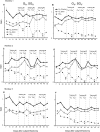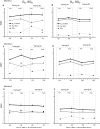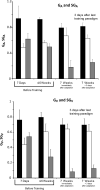Unidirectional rotations produce asymmetric changes in horizontal VOR gain before and after unilateral labyrinthectomy in macaques
- PMID: 21431432
- PMCID: PMC3270067
- DOI: 10.1007/s00221-011-2622-2
Unidirectional rotations produce asymmetric changes in horizontal VOR gain before and after unilateral labyrinthectomy in macaques
Abstract
Unilateral vestibular lesions cause marked asymmetry in the horizontal vestibulo-ocular reflex (VOR) during rapid head rotations, with VOR gain being lower for head rotations toward the lesion than for rotations in the opposite direction. Reducing this gain asymmetry by enhancing ipsilesional responses would be an important step toward improving gaze stability following vestibular lesions. To that end, there were two goals in this study. First, we wanted to determine whether we could selectively increase VOR gain in only one rotational direction in normal monkeys by exposing them to a training session comprised of a 3-h series of rotations in only one direction (1,000°/s² acceleration to a plateau of 150°/s for 1 s) while they wore 1.7 × magnifying spectacles. Second, in monkeys with unilateral vestibular lesions, we designed a paradigm intended to reduce the gain asymmetry by rotating the monkeys toward the side of the lesion in the same way as above but without spectacles. There were three main findings (1) unidirectional rotations with magnifying spectacles result in gain asymmetry in normal monkeys, (2) gain asymmetry is reduced when animals are rotated towards the side of the labyrinthectomy via the ipsilesional rotation paradigm, and (3) repeated training causes lasting reduction in VOR gain asymmetry.
Figures





Similar articles
-
Dynamics of the horizontal vestibuloocular reflex after unilateral labyrinthectomy: response to high frequency, high acceleration, and high velocity rotations.Exp Brain Res. 2006 Nov;175(3):471-84. doi: 10.1007/s00221-006-0567-7. Epub 2006 Jun 29. Exp Brain Res. 2006. PMID: 16957885
-
Unilateral adaptation of the human angular vestibulo-ocular reflex.J Assoc Res Otolaryngol. 2013 Feb;14(1):29-36. doi: 10.1007/s10162-012-0359-7. Epub 2012 Nov 21. J Assoc Res Otolaryngol. 2013. PMID: 23180230 Free PMC article.
-
The mammalian efferent vestibular system plays a crucial role in vestibulo-ocular reflex compensation after unilateral labyrinthectomy.J Neurophysiol. 2017 Apr 1;117(4):1553-1568. doi: 10.1152/jn.01049.2015. Epub 2017 Jan 11. J Neurophysiol. 2017. PMID: 28077670 Free PMC article.
-
Acute unilateral loss of vestibular function.Handb Clin Neurol. 2016;137:219-29. doi: 10.1016/B978-0-444-63437-5.00015-7. Handb Clin Neurol. 2016. PMID: 27638073 Review.
-
New advances regarding adaptation of the vestibulo-ocular reflex.J Neurophysiol. 2019 Aug 1;122(2):644-658. doi: 10.1152/jn.00729.2018. Epub 2019 Jun 19. J Neurophysiol. 2019. PMID: 31215309 Review.
Cited by
-
Responses of central vestibular neurons to sinusoidal yaw rotation in compensated macaques after unilateral labyrinthectomy.J Neurophysiol. 2013 Oct;110(8):1822-36. doi: 10.1152/jn.00365.2013. Epub 2013 Jul 17. J Neurophysiol. 2013. PMID: 23864379 Free PMC article.
-
Directional plasticity rapidly improves 3D vestibulo-ocular reflex alignment in monkeys using a multichannel vestibular prosthesis.J Assoc Res Otolaryngol. 2013 Dec;14(6):863-77. doi: 10.1007/s10162-013-0413-0. Epub 2013 Sep 8. J Assoc Res Otolaryngol. 2013. PMID: 24013822 Free PMC article.
-
Association of the Video Head Impulse Test With Improvement of Dynamic Balance and Fall Risk in Patients With Dizziness.JAMA Otolaryngol Head Neck Surg. 2018 Aug 1;144(8):696-703. doi: 10.1001/jamaoto.2018.0650. JAMA Otolaryngol Head Neck Surg. 2018. PMID: 29955786 Free PMC article.
-
Rebalancing the Vestibular System by Unidirectional Rotations in Patients With Chronic Vestibular Dysfunction.Front Neurol. 2019 Jan 22;9:1196. doi: 10.3389/fneur.2018.01196. eCollection 2018. Front Neurol. 2019. PMID: 30723455 Free PMC article.
-
Neurovestibular Compensation following Ototoxic Lesion and Labyrinthectomy.Int Arch Otorhinolaryngol. 2016 Apr;20(2):114-23. doi: 10.1055/s-0036-1572527. Epub 2016 Mar 10. Int Arch Otorhinolaryngol. 2016. PMID: 27096015 Free PMC article.
References
-
- Aoki M, Burchill P, Ito Y, Gresty M. Asymmetry of vestibular function induced by unidirectional visual-vestibular conflict. Acta Otolaryngol. 1998;118:628–634. - PubMed
-
- Aw ST, Halmagyi GM, Haslwanter T, Curthoys IS, Yavor RA, Todd MJ. Three-dimensional vector analysis of the human vestibulo-ocular reflex in response to high acceleration head rotations II.Responses in subjects with unilateral vestibular loss and selective semicircular canal occlusion. J Neurophysiol. 1996;76:4021–4030. - PubMed
-
- Baloh RW, Honrubia V, Yee RD, Hess K. Changes in the human vestibulo-ocular reflex after loss of peripheral sensitivity. Ann Neurol. 1984;16:222–228. - PubMed
-
- Carey JP, Migliaccio AA, Minor LB. Semicircular canal function before and after surgery for superior canal dehiscence. Otol Neurotol. 2007;28:356–364. - PubMed
Publication types
MeSH terms
Grants and funding
LinkOut - more resources
Full Text Sources

